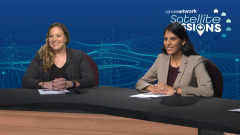
Treatment Paradigm for Patients With Transplant Ineligible NDMM
Centering discussion on transplant ineligible multiple myeloma, expert panelists review mainstay treatment regimens and strategies in the first-line setting.
Episodes in this series

Transcript:
Krina K. Patel, MD, MSc: In terms of your transplant-ineligible patients, what is the way you choose induction regimens?
Melody R. Becnel, MD: For transplant-ineligible, I think DARA-DEX [daratumumab and dexamethasone] is pretty much my go-to unless there’s some, for example, pulmonary issue that would preclude choosing daratumumab.
Krina K. Patel, MD, MSc: This is if their PFTs [pulmonary function tests] are OK. We have ways to mitigate it, but I agree with you.
Melody R. Becnel, MD: For the most part, for a typical transplant-ineligible patient, I choose daratumumab, Revlimid, dexamethasone, at least 8 to 12 cycles, reassess, and then I’d probably keep them on a maintenance approach with daratumumab and Revlimid if they tolerated it thereafter.
Tejo N. Musunuru, MD: To bring up the lung toxicity with daratumumab, I haven’t seen a whole lot, even for those patients with advanced COPD [chronic obstructive pulmonary disease]. I’ve been able to use daratumumab a lot. Have you noticed any excess toxicity to the point that you had to stop treatment in a lot of different patients?
Krina K. Patel, MD, MSc: It’s only been one or two. Again, this was not necessarily the drug itself, it is well tolerated.
Tejo N. Musunuru, MD: It comes up a lot more than what we see, I feel. That’s why I thought I’d mention that.
Krina K. Patel, MD, MSc: Same thing with the anemia and the red blood cell. That’s more so that if they need transfusions, we have their antibody panel already before they get daratumumab, but I agree.
Tejo N. Musunuru, MD: I see a lot more thrombocytopenia than anemia with daratumumab.
Krina K. Patel, MD, MSc: It is all easy to manage overall. We talked about high risk. That would be a group that I’m thinking most of us would say the [quadruplet regimens], or we want to make sure carfilzomib is included in that. Are there any of your standard-risk patients you would want to do a quad for rather than a triplet? Any characteristics that would say, I want to do a quad for this patient even though they’re standard risk?
Tejo N. Musunuru, MD: Probably the young patients who don’t have any other organ dysfunction and they would like to preserve quality of life and have a better PFS [progression-free survival]. Even the 1% matters kind of a patient. Those are the ones for whom I’d probably go with the quad as opposed to the triplet.
Melody R. Becnel, MD: It’s probably the same for me. Patients who tell me, “I want to do everything I possibly can.” Kind of the same thing.
Krina K. Patel, MD, MSc: Perfect. Coming back to the transplant-ineligible again, we talked about the MAIA study. Is there ever anybody you would give, based on the SWOG data, VRd [bortezomib, lenalidomide, dexamethasone]-lite? I used to do that a lot more before. I’ve gotten a bit away from it just because of the neuropathy. But is there anybody you think of that you would do that for instead?
Melody R. Becnel, MD: I think…if for some reason someone had severe pulmonary disease, then maybe I would forego daratumumab out of caution and do VRd-lite, but I don’t use it a lot.
Tejo N. Musunuru, MD: Same here.
Krina K. Patel, MD, MSc: Perfect, we have a consensus. Then how do you define frailty? Even in the patients who are transplant eligible, we talked about frail versus not frail. Who would you consider as frail?
Tejo N. Musunuru, MD: I would say that is a moving target in a way because when they first come in and they have a lot of disease, most of them look frail. After a couple of cycles of treatment, they feel great. One thing about myeloma, they feel great after like 2 cycles of treatment. The whole thing about the frailty is like, “Oh, I feel great,” and that’s when the bar changes. The talks about transplant eligibility come forward a little more than what they were before. Frailty to me is when they first come in, are they able to do their activities on a daily basis? How much help are they needing to move around the house or come for their appointments? Organ dysfunction is the other one. Those are probably the biggest things for me to think about with frailty, more than anything else.
Krina K. Patel, MD, MSc: I agree. I think there are a lot of great people out there doing research on this and a lot of tools we can use. I would say the issue is being able to use it in the clinic when we need to. That’s the hard part, so I agree with you. I think some of those questions about what you are able to do, and if family members start answering questions for my patients, that’s always a red flag. I’m like, wait, why are you answering for them? Again, I think with these types of therapies though, even today we talked about patients with early dementia on steroids. You can decrease steroids and our patients can do really well. There are different things you can do to still get our patients who are frail through this.
Tejo N. Musunuru, MD: That brings up a very good point. I have stopped using steroids for the most part for anything consolidation and maintenance. Most of my consolidative and maintenance regimens don’t involve, we say triplet, but that does not involve the steroid.
Krina K. Patel, MD, MSc: Then do you ever use a doublet?
Tejo N. Musunuru, MD: Yes, I think most of them are actually doublets without steroids.
Krina K. Patel, MD, MSc: Without the steroids. Got it. So, a different definition of a doublet, it’s a steroid plus something.
Sairah Ahmed, MD: I think just to come back to frailty, you’re absolutely right. It’s really difficult in the clinic to elicit, and I think using objective measures is important since there are lots of online tools and a lot of research that’s gone into it. But in the transplant world, I think the sniff test doesn’t work. You see a patient in the clinic for a very short amount of time and they look great, but that doesn’t really give you a real indication of how frail they are. Using some of these objective measures like the 6-minute walk test, and the get-up-and-go test, I think is important. As we start to treat patients who are transplant ineligible, or who are ineligible for intensive therapy, categorizing that in a fashion where you can then say, “Hey, this is where you were, this is where you are, you’ve improved this much” is important. It’s an objective measure rather than a subjective measure.
Krina K. Patel, MD, MSc: I completely agree. Especially with CAR [chimeric antigen receptor] T-cell and bispecific therapy that we’re going to talk about. Even our older patients who look like they’re doing great, their reserve is very different than younger patients, so I completely agree with you. It’s how do we figure out how to do it?
Tejo N. Musunuru, MD: One thing I try to do for these patients is, if they’re in a wheelchair, we know they’re frail. As we go on during the treatment, sometimes I walk with them. One good thing about being in a satellite center is it’s not a lot of space, so Isometimes walk with them to the elevator and see what they can do. Because they’re going to the infusion center upstairs, I lead the way and walk with them, talk with them for a few minutes. It gives me a better idea for the ones I don’t know, especially when the caregiver is saying something and the patient’s saying something else. Those are the ones I try to do that as a little test with to see if I should even send them to a transplant or not.
Krina K. Patel, MD, MSc: I was going to ask you, Melody, because you do a lot of virtual visits like I do, how do you do those sorts of things? That’s been my other bigger issue, that I didn’t realize a patient wasn’t doing well because they didn’t tell me. Then they show up in the clinic with a cane and they weren’t before. Virtual medicine.
Melody R. Becnel, MD: I feel like you can get a fair assessment virtually by asking them. Then the family, the family is the biggest tattletale for everything. I think the family is honest, and they’re going to give us a good assessment. I do a lot of virtual visits. I want to see the patient in person at least once if I can, unless they just want my opinion once. But I feel like there is not a lot of discordance between when I see them virtually and then in person, from an interview perspective.
Krina K. Patel, MD, MSc: I agree. I think it makes it so much easier for our patients to be able to do that and then go to treatment. But I still think that sometimes that walk test tells me much more than when they’re sitting down and they’re like, “everything’s great.”
Melody R. Becnel, MD: There was once a patient where I was doing a virtual visit and he was lying in the bed. I’m thinking, is this for comfort? And it was. You’ve just got to ask them to move around.
Krina K. Patel, MD, MSc: Make sure there’s no bone disease, exactly.
Transcript edited for clarity.
Newsletter
Stay up to date on recent advances in the multidisciplinary approach to cancer.






















































































